New products at Crocus
by Sarah - May 13th, 2010.Filed under: Crocus, New Products.
Crocus has these new items today

large-versailles-planter-box £49.99
A superb value hardwood planter made from yellow balau wood. Make an eye catching feature by planting a standard bay laurel in this elegant planter.Available in 2 Sizes Measurements:Medium – Width: 35cm x Depth: 35cm x Height: 45cmLarge – Width: 45cm x Depth: 45cm x Height: 45cmTo preserve wooden furniture, it is advisable to treat it annually. In extreme weather conditions, like a hot summer, the surface of timber will rapidly loose moisture content, causing it to shrink and split. Treating your furniture with a proprietary product will reduce the chance of this happening.
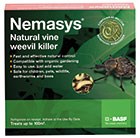
large-nemasys-vine-weevil-killer £29.99
If ordered on its own Nemasys is posted 1st class therefore we only charge £1 for postage and packagingNemasys Vine Weevil Killer effectively controls vine weevils with no risks to children, pets and wildlife. It controls vine weevil at the larvae stage when they are living in the soil and are at their most destructive. Nemasys contains millions of nematodes, the natural enemies of vine weevil. Once applied by watering can they actively seek out and kill vine weevil larvae. Unlike other chemicals, this is effective against all larval stages. Apply between March and November, when vine weevil larvae are present andwhen the soil temperature is above 5°C in the daytime.N.B. Generally from late June vine weevil outside will be growing out of the larval stages so are not susceptible to nematode attack. They will be at the larval stage again in late August and September. However if you need to control vine weevil in a greenhouse or a conservatory, Nemasys can be used at any time of year providing the soil temperature is above 5°C.1 x 6 million pack treats 160 x 30cm pots or 12sqm. (14sq yards)1 x 50 million pack treats 1,200 x 30cm pots or 100sqm.It is best to refrigerate the product when you receive it and use as soon as possible.Vine weevil larvae are killed within two to three weeks.How to useTake half of the pack contents and add to a 8 litre (2 gallon) watering can fill with clean water and mix thoroughly. Apply immediately using a coarse rose on the watering can, to half of the area to be treated. then apply an equal ammount of water to the treated area.

nemasys-caterpillar-and-codling-moth-killer £19.99
If ordered on its own Nemasys is posted 1st class therefore we only charge £1 for postage and packagingCaterpillars, the larval stage of several butterfly and moth species, cause damage to many plants and crops.The other parts of the butterfly / moth life cycle i.e. egg , pupae and adults do not harm plants, with the butterflies mainly feeding on nectar. The damage caused by caterpillars can resemble holes in the leaves or ragged edges to the leaves. Damage can be severe and plants can be disfigured by large amounts of caterpillar excrement.What damage do caterpillars and codling moth do and how do I recognise it?:Cabbage White Caterpillars can decimate a vegetable plot, especially brassicas or ornamental beds, especially nasturtiums. The Large Cabbage White feeds mainly on the outer leaves leaving holes and sometimes completely stripping leaves. The Small Cabbage White feeds mainly on the hearts of cabbages and other brassicas. By the time that the fruit is ready for picking the Gooseberry Sawfly can completely strip the leaves of the fruit bushes leaving them severely. The Codling Moth feeds on the core of the fruit of apples and pear and to a lesser extent walnut and quince. When they have eaten the fruit they exit leaving a small reddish brown hole in the skin with brown droppings know as frass. Upon cutting the fruit find that there is very little left that can be eaten.To control caterpillar infestations safely.To control caterpillars apply as soon as the caterpillars are first seen applying to all leaf surfaces where the pest is present. Make sure to spray pests with a solution as caterpillars not directly sprayed will not be controlled. To control Codling Moths apply September to October to the trunk of the tree/main branches and to an area of soil equal to the tree cover above. Wet the area before applying the nematodes and apply with a pump sprayer so that all areas are treated. The pack contains sufficient for two further applications at 5 to 7 day intervals, this ensures that all hatchings are targeted.The nematodes (Steinernema carpocapsae), attack the pest by entering natural body openings. Once inside, they release bacteria that stops the larvae from feeding, quickly killing it and breaking the pest’s lifecycle.This pack to treat 3 x 40m2 of open ground or up to 20 trees.
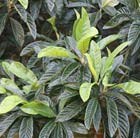
Japanese loquat £17.99
Position: full sunSoil: fertile, well-drained soilRate of growth: fast-growing Flowering period: September to December Flower colour: whiteOther features: the flowers are followed occasionally in spring by pear-shaped, edible, orange-yellow fruit;Hardiness: frost hardyWhorls of handsome, boldly veined, dark-green leaves provide a foil for clusters of fragrant, white flowers in autumn. This vigorous, evergreen shrub is perfect for growing against a large, sheltered, sunny wall. For maximum results provide fertile, well-drained soil and adequate space for the plant to spread.Garden care: Requires minimal pruning. In February or March remove any misplaced, diseased or dead branches to maintain a permanent, healthy framework

yellow-groove bamboo £16.99
Position: full sun or partial shadeSoil: humus-rich, moist, well-drained soilRate of growth: averageLeaves: mid-greenCanes: rich yellowHardiness: fully hardyA tall, coloured-stemmed bamboo with rich yellow canes with a few green stripes at the base. This green leaved bamboo looks spectacular grown as a specimen. One of our ‘highly recommended plants’, it should be planted next to a building or path where the near-luminous, yellow to burnt orange coloured canes can be enjoyed all year.Garden care: Plant in a large container or surround the roots with a non-perishable barrier that restricts the plant’s spread.
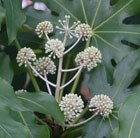
Japanese aralia £15.99
Position: full sun or partial shadeSoil: moist, well-drained soilRate of growth: averageFlowering period: September and OctoberFlower colour: creamy whiteHardiness: frost hardy (needs winter protection)A tropical-looking, evergreen shrub with gorgeously glossy, deep green palmate leaves. In autumn, creamy white flowers are produced in large panicles, which are often followed by round, black fruit. It makes a superb feature in an exotic-style garden, where the large leaves team well with bamboos and grasses.Garden care: Prune lightly in mid- to late spring, trimming shoots that spoil the symmetry. Protect plants from cold, drying winds
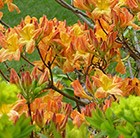
deciduous azalea £14.99
Position: partial shadeSoil: moist, well-drained, humus-rich, acid soil or ericaceous compostRate of growth: averageFlowering period: MayFlower colour: orangeOther features: looks stunning planted ‘en masse’Hardiness: fully hardyGlorious trusses of glowing, golden-orange, funnel shaped flowers in late spring, opening from coppery-red buds, and medium sized, mid-green leaves. This deciduous azalea looks stunning planted ‘en masse’ in a sunny shrub border with humus-rich, acid soil. Winter flowering shrubs are good companions, providing interest after it has lost its beautiful autumn leaves.Garden care: Avoid planting too deeply. Apply a generous 5-7cm (2-3in) mulch of leaf mould around the base of the plant each spring.
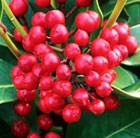
Japanese skimmia (female) £12.99
Position: partial to full shadeSoil: moderately fertile, moist but well-drained soilRate of growth: averageFlowering period: April to May Flower colour: whiteOther features: the flowers are followed by bright red berries as long as a male variety is planted close byHardiness: fully hardyA spreading, evergreen shrub with white flowers in April and May and slightly aromatic, lance-shaped, dark green leaves. This award-winning shrub provides much-needed colour in the winter garden. Ideal for a shady shrub or mixed border, the flowers are followed by long lasting, bright red berries as long as a male variety is planted close by.Garden care: Lightly trim after flowering, if necessary. Add plenty of well-rotted compost when planting as may become chlorotic if planted on poor, dry soils.
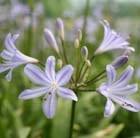
African lily £12.99
Position: full sunSoil: fertile, moist, well-drained soil (or John Innes no. 3 compost for containers) Rate of growth: average Flowering period:July to SeptemberHardiness: half hardy (will need protection in winter)A variable, short variety that originates from New Zealand. It produces loose clusters of light blue, trumpet-shaped flowers that gently flare towards the ends. These appear above the glossy, strap-shaped, evergreen foliage in July and August.Garden care: Keep well-watered during the growing season, applying a balanced liquid fertiliser each month from spring until the plant flowers. In cold, exposed areas protect the crown of the plant with a deep, dry winter mulch, and avoid too much winter wet.
White Fig £12.99
Black Fig £12.99
clematis (group 3) £12.99
Skimmia (female) £12.99
grape £11.99
Adam’s needle £9.99
clematis (group 1) £8.99
delphinium £8.99






